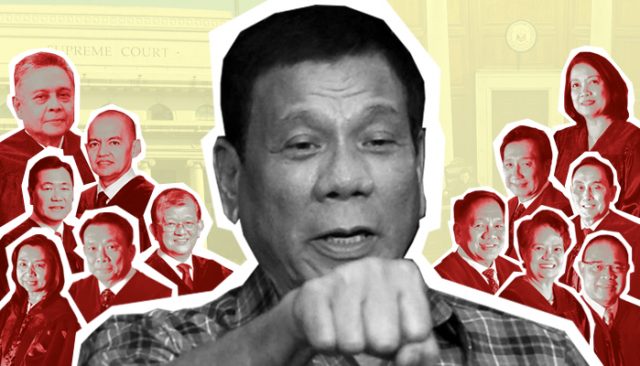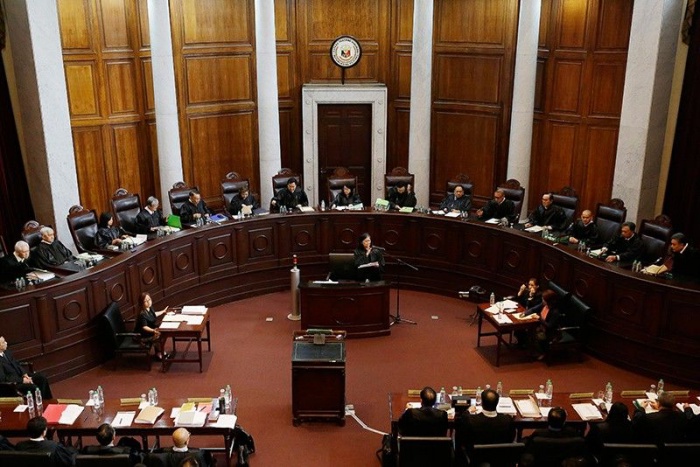
The Supreme Court’s decision to oust Chief Justice Maria Lourdes Sereno with a vote of 8-6 has brought into light a division among justices that is also evident in their voting pattern on major cases under the Duterte administration.


Bail of Juan Ponce Enrile
Vote: 7-6 in favor of allowing Enrile to post bail
In 2014, Enrile was arrested for misusing P172.8 million of his Priority Development Assistance Fund from 2004 to 2010. This led him to be charged for graft and plunder, along with Jinggoy Estrada and Bong Revilla.
The octogenarian Enrile has filed for reconsideration several times. By 2015, the SC allowed him to post bail due to health and humanitarian reasons reasons. In July 2016, the high court stood by its decision against the appeal that was filed by the Ombudsman.
In March 2017, the senator met with Duterte two weeks after supposed scam mastermind Janet Lim-Napoles was acquitted of pork barrel scam charges.
The president denied that he had a hand in Enrile’s bail and said that the senator gave him advice on issues such as the anti-narcotics campaign, among others.
Acquittal of Gloria Arroyo’s Plunder Case
Vote: 11-4 allowing her acquittal
On 2012, Arroyo was charged for allegedly misusing the funds of the Philippine Charity Sweepstakes Office that amounted to P366 million. She was charged with plunder.
By July 2016, SC voted for her to be acquitted, citing that “there was no proof of any amassing, or accumulating, or acquiring ill-gotten wealth of at least P50 million.”
Subsequent to the prosecution, Arroyo openly thanked Duterte and the high court for “allowing due process to take its course totally unhampered.”
Ferdinand Marcos’ burial at the Libingan ng mga Bayani
Vote: 10-5 allowing the burial
On November 2016, SC allowed Duterte’s order to have Marcos’ remains transferred to the Libingan ng mga Bayani. No media were allowed to cover the burial. The move has sparked protests and condemnation from several groups, including Vice President Leni Robredo.
Libingan ng mga Bayani is a resting place of deceased presidents, national heroes, patriots, national artists and national scientists.
Ilocos Norte Governor Imee Marcos expressed her elation for the SC’s ruling despite Senior Associate Justice Antonio Carpio saying that Marcos was “dishonorably” discharged from his presidency.
Petition of De Lima to nullify arrest for drug trade charges
Vote: 9-6 denying De Lima’s petition
In August 2016, Duterte accused De Lima of being involved in the Bilibid drug trade, despite her opening its investigation under her stint as the Department of Justice’s secretary.
By February 2017, a warrant of arrest was issued against her for drug trafficking.
De Lima filed a petition before the SC to nullify the arrest due to “lack of jurisdiction” but a majority decision in favor of government kept her behind bars.
Despite this, she was included in Forbes Magazine’s list of “World’s 50 Greatest Leaders” for her vocal outcry against state-tolerated killings.
Year-long extension of martial law in Mindanao
Vote: 10-5 in favor of allowing the extension
In May 2017, government troops clashed with Maute terrorists in an attempt to arrest Abu Sayaff sub-leader Isnilon Hapilon, who was accused of being affiliated with the brutal Islamic State in the Middle East.
The crisis prompted Duterte to put the whole region of Mindanao under martial law for 60 days.
However, the president requested for it to be extended until Dec. 31, 2018. Petitions have been filed against the extension, with Movement Against Tyranny saying it is unconstitutional and a threat to human rights.
The SC junked the petitions and noted that the extension has factual basis. According to them, “public safety requires the extension, as shown by facts presented by the [Armed Forces of the Philippines].”
Quo warranto petition challenging the appointment of Chief Justice Sereno
Vote: 8-6 in favor of removing Sereno and voiding her appointment
In January 2017, lawyer Lorenzo Gadon filed a complaint that accused Sereno of failing to file her Statements of Assets, Liabilities and Net Worth (SALN).
By February 2018, the SC coerced her to take an “indefinite leave” as impeachment proceedings started at the lower house where she was accused of failing to submit requirements merited for her appointment in 2012, among other accusations.
Solicitor General Jose Calida then filed a quo warranto petition against Sereno, questioning former President Noynoy Aquino’s appointment of her.
The petition has led to the now-controversial decision by magistrates to oust its chief justice in a move that may have “constitutional consequences.” Several legal experts have stressed, however, that Sereno may only be ousted through impeachment.
How the Supreme Court decides
The Supreme Court consists of 14 justices who are presided over by the chief justice, considered the highest judicial officer in the Philippines.
Former chief justice Artemio Panganiban, who led the high court from 2005 to 2007, explained it in an opinion piece.
He debunked misconceptions against justices’ decisions and wrote that they are not supposed to not handle cases based on religious beliefs, the alma mater they graduated from and the president who appointed them in the first place.

Panganiban shared that a petition is first submitted to a “member-in-charge” or an MIC who decides if the case should be handled by 15 justices (en banc) or by one of three court divisions (of five justices each).
After which, the MIC submits a summary of facts, issues and arguments of the case. A decision will be made whether the case would be dismissed for “lack of merit” or if it will “require a comment from the respondents.”
Once a comment is received, the court may thoroughly dismiss the petition, hold oral arguments, or ask a submission of written memoranda.
After the MIC receives the memoranda, he is to write a report on how the case should be handled. Deliberations by the justices follow.
Panganiban wrote, “If the justices agree with the recommendation, the MIC then prepares the decision. Should the justices, by majority vote, disagree, another justice is assigned to write the decision and the MIC submits a dissent.” — Infographics by Uela Badayos









